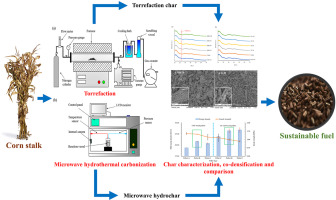当前位置:
X-MOL 学术
›
Environ. Res.
›
论文详情
Our official English website, www.x-mol.net, welcomes your
feedback! (Note: you will need to create a separate account there.)
Enhanced fuel characteristics and physical chemistry of microwave hydrochar for sustainable fuel pellet production via co-densification.
Environmental Research ( IF 7.7 ) Pub Date : 2020-04-08 , DOI: 10.1016/j.envres.2020.109480 Kang Kang 1 , Sonil Nanda 2 , Su Shiung Lam 3 , Tianle Zhang 4 , Lili Huo 5 , Lixin Zhao 5
Environmental Research ( IF 7.7 ) Pub Date : 2020-04-08 , DOI: 10.1016/j.envres.2020.109480 Kang Kang 1 , Sonil Nanda 2 , Su Shiung Lam 3 , Tianle Zhang 4 , Lili Huo 5 , Lixin Zhao 5
Affiliation

|
Microwave assisted hydrothermal treatment (MHTC) was compared with torrefaction in terms of carbonization efficiency and physicochemical characteristics of char products. The utilization of produced char was optimized for composite solid biofuel production. The results show that MHTC significantly improved the binding capability of the microwave hydrochar (MHC) particles during co-densification with unprocessed biomass and coal. One possible contributor to the improved binding is the pseudo lignin formed during the MHTC, which led to a better interlocking of the feedstock particles and promoted the solid bridge formation. Composite pellet prepared with 80 wt% of torrefaction char (TC-120), 10 wt% of microwave hydrochar (MHC-30), and 10 wt% of Coal-04 showed a higher heating value of 24.54 MJ/kg and energy density of 26.43 GJ/m3, which is significantly higher than that of the raw cotton stalk pellet (16.77 MJ/kg and 18.76 GJ/m3, respectively), showing great promise as a solid biofuel. The moisture resistance and oxidation reactivity are also significantly improved. The results demonstrate that MHCs provides dual functionalities in acting as binder and fuel promoter in the production of composite biofuel. This study can provide new insight into the unique functions of MHC during fuel application, which demonstrates the great potential of applying MHTC in energy recovery from lignocellulosic biomass.
中文翻译:

通过共密化,增强了微波水煤油的燃料特性和物理化学,可实现可持续的燃料颗粒生产。
在炭化效率和炭产品的理化特性方面,将微波辅助水热处理(MHTC)与焙烧进行了比较。所生产的焦炭的利用率已针对复合固体生物燃料生产进行了优化。结果表明,MHTC显着提高了与未处理的生物质和煤共同致密化过程中微波水煤(MHC)颗粒的结合能力。MHTC过程中形成的假木质素可能是导致结合力提高的原因,它导致原料颗粒更好的互锁并促进了固体桥的形成。用80 wt%的焙烧炭(TC-120),10 wt%的微波水焦(MHC-30)和10 wt%的Coal-04制备的复合颗粒显示出更高的发热量24.54 MJ / kg和能量密度26.43 GJ / m3,它显着高于原棉秸秆颗粒(分别为16.77 MJ / kg和18.76 GJ / m3),显示出作为固体生物燃料的巨大希望。耐湿性和氧化反应性也显着提高。结果表明,MHC在合成生物燃料的生产中具有双重功能,可充当粘合剂和燃料促进剂。这项研究可以提供新的见解,在燃料应用过程中MHC的独特功能,这证明了将MHTC应用在木质纤维素生物质能量回收中的巨大潜力。结果表明,MHC在合成生物燃料的生产中具有双重功能,可充当粘合剂和燃料促进剂。这项研究可以提供新的见解,在燃料应用过程中MHC的独特功能,这证明了将MHTC应用在木质纤维素生物质能量回收中的巨大潜力。结果表明,MHC在合成生物燃料的生产中具有双重功能,可充当粘合剂和燃料促进剂。这项研究可以提供新的见解,在燃料应用过程中MHC的独特功能,这证明了将MHTC应用在木质纤维素生物质能量回收中的巨大潜力。
更新日期:2020-04-08
中文翻译:

通过共密化,增强了微波水煤油的燃料特性和物理化学,可实现可持续的燃料颗粒生产。
在炭化效率和炭产品的理化特性方面,将微波辅助水热处理(MHTC)与焙烧进行了比较。所生产的焦炭的利用率已针对复合固体生物燃料生产进行了优化。结果表明,MHTC显着提高了与未处理的生物质和煤共同致密化过程中微波水煤(MHC)颗粒的结合能力。MHTC过程中形成的假木质素可能是导致结合力提高的原因,它导致原料颗粒更好的互锁并促进了固体桥的形成。用80 wt%的焙烧炭(TC-120),10 wt%的微波水焦(MHC-30)和10 wt%的Coal-04制备的复合颗粒显示出更高的发热量24.54 MJ / kg和能量密度26.43 GJ / m3,它显着高于原棉秸秆颗粒(分别为16.77 MJ / kg和18.76 GJ / m3),显示出作为固体生物燃料的巨大希望。耐湿性和氧化反应性也显着提高。结果表明,MHC在合成生物燃料的生产中具有双重功能,可充当粘合剂和燃料促进剂。这项研究可以提供新的见解,在燃料应用过程中MHC的独特功能,这证明了将MHTC应用在木质纤维素生物质能量回收中的巨大潜力。结果表明,MHC在合成生物燃料的生产中具有双重功能,可充当粘合剂和燃料促进剂。这项研究可以提供新的见解,在燃料应用过程中MHC的独特功能,这证明了将MHTC应用在木质纤维素生物质能量回收中的巨大潜力。结果表明,MHC在合成生物燃料的生产中具有双重功能,可充当粘合剂和燃料促进剂。这项研究可以提供新的见解,在燃料应用过程中MHC的独特功能,这证明了将MHTC应用在木质纤维素生物质能量回收中的巨大潜力。











































 京公网安备 11010802027423号
京公网安备 11010802027423号